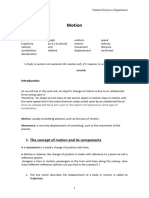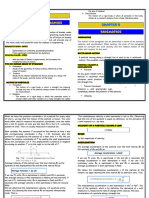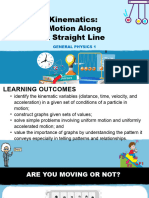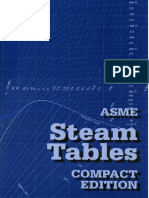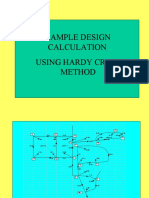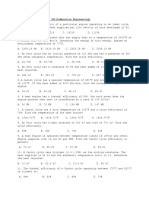Dynamics Module 1-1
Uploaded by
patrickacev.perezDynamics Module 1-1
Uploaded by
patrickacev.perezRomblon State University
Department of Civil Engineering
MODULE 1
DYNAMICS OF RIGID d. Velocity - a vector quantity that refers to
BODIES - MECH 2202 "the rate at which an object changes its
Instructor: Engr. Mary Joy M. Fruelda position." If the particle moves through a
displacement ∆𝑠 during the time interval ∆𝑡
1. INTRODUCTION the average velocity of the particle during this
Dynamics - is the branch of mechanics time interval is
that deals with bodies in motion in relation to
physical forces that affect them: force, mass,
momentum, energy.
Kinematics – deals with the geometry of
motion. This term is used to define the motion
of a particle or body without consideration of ➢ If the
the forces causing the motion. It is essentially a particle in
treatment of the relations between the figure below travels along the path
displacement, velocity, and acceleration. of length 𝑠𝑇 in time 𝑡, so its average
Kinetics is a study of the forces that speed is
cause the motion.
SCALAR AND VECTOR QUANTITIES but its average velocity is
a. Distance - scalar quantity that refers to "
how much an object has covered during its
motion.
a. Displacement - is a vector quantity that Acceleration is a vector quantity that is
refers to "how far out of place an object is"; it is defined as the rate at which an object changes
the object's overall change in position. its velocity with respect to time.
TYPES OF MOTION
1. Translational motion is the motion by
which a body shifts from one point in space to
another.
b. Speed - a scalar quantity that refers to a. Rectilinear motion - position, velocity,
"how fast an object is moving." Speed can be and acceleration of a particle as it
thought of as the rate at which an object moves along a straight line.
covers distance. The magnitude of the velocity b. Curvilinear motion - motion that
is known as the speed, and it is generally occurs when a particle travels along a
expressed in units of m/s or ft/s. curved path. The curved path can be in
two dimensions (in a plane), or in three
Occasionally, the term “average speed” is dimensions.
used. The average speed is always a positive 2. Rotational motion is the motion by which
scalar and is defined as the total distance a body moves in circles and that the centers of
traveled by a these circles all on one line called the axis of
particle, 𝑠𝑇 , divided by the elapsed time ∆𝑡. rotation.
3. Periodic motion is the motion by which a
body vibrates or oscillates back and forth, over
the same path, each oscillation taking the same
amount of time
Differential Kinematic Equations of 3. The figure shows a train traveling at a
Motion constant uniform velocity of 75 kph and a car
travelling at a speed of 36 kph towards point O.
If a relation is known between any two a. If train moves at a uniform velocity, compute
of the four variables a, v, s, and t, the required time (t) for the train to reach the
then a third variable can be obtained point of collision O. 48s
by using one of the kinematic
equations, a=dv/dt, v=ds/dt or b. Compute the acceleration of the car if the car
ads=v dv, since each equation reaches point O, 10 seconds ahead than that of
relates all three variables. the train. 0.859m/s2
𝒅𝒔
𝒗= c. Using the computed acceleration at (b), solve
𝒅𝒕
for the velocity of the car at the collision point.
𝒅𝒗 153.5 kph
𝒂=
𝒅𝒕
𝒂𝒅𝒔 = 𝒗𝒅𝒗 4. An automobile starting from rest speeds up
to 40 meters per second with a constant
1.1 Kinematics in One acceleration of 4 m/s2, runs at this speed for a
time, and finally comes to rest with a
Dimension – Rectilinear
deceleration of 5 m/s2. If the total distance
Translation traveled is 1000 meters.
a. Find the distance covered during the
A. Uniform Motion (velocity is acceleration. 200m
constant) b. Find the distance traveled at constant
speed. 640m
𝒔 = 𝒗𝒕 c. Find the total time of travel. 34s
B. Uniform acceleration (acceleration is
constant)
𝟏 𝟐
𝑺 = 𝒗𝑶 𝒕 + 𝒂𝒕
𝟐
𝒗𝒇 𝟐 = 𝒗𝒐 𝟐 + 𝟐𝒂𝒔
𝒗𝒇 = 𝒗𝒐 + 𝒂𝒕
Sample Problems:
1. A car passes through point A with a velocity of
20 m/s and travels constantly in a straight path
to the right.
a. How far from Point A will it reach in 10
seconds? 200 meters
b. When will it reach a distance of 500 meters
from Point A?
Ans. 25 seconds
2. A policeman fires a target with a bullet’s
velocity of 900 m/s. After 2.5 seconds, he
hears the sound of the bullet that strikes
the target. Assuming that sound has a
constant velocity of 350 m/s, how far is the
target from the man. 630m
1.1.a Translation with 3. The motion of a particle starting from initial
velocity of 5 ft/s is governed by
Variable Acceleration the a-t diagram shown.
Variable acceleration occurs when bodies are
acted upon by variable forces. To determine the
kinematic equations of motions in such cases, it
is necessary to apply the given data to the
differential equations of kinematics. Since the
acceleration may vary in many ways, no general
equations can be stated as was done in the case
of constant acceleration.
Solution by formula: a. 1.Determine the velocity at t = 6
seconds
𝒅𝒔 b. 2. Determine the velocity at t = 9
𝒗= seconds
𝒅𝒕 c. 3.Determine the displacement at t = 6
seconds
𝒅𝒗
𝒂= d. 4.Determine the displacement at t = 9
𝒅𝒕 seconds
𝒂𝒅𝒔 = 𝒗𝒅𝒗
Graphical Solution:
Using a-t diagram:
Δv = change in area of the a-t diagram
Δs = vot + change in moment of area of
the a-t diagram
Using v-t diagram:
Δs = change in area of the v-t diagram
Examples:
1. Determine the velocity and acceleration of
a body after 3 sec, if the motion is defined by
the relation 𝑠 = 5𝑡 + 4𝑡3, s being in feet and t
is in seconds.
Answer v = 113 feet/ sec , a = 72 feet/ sec2
2. The position of a particle which moves
along a straight line is defined by the relation
s = t3 - 6t2 - 15t + 40, where x is expressed
in meters and t in seconds. Determine:
a. the time at which the velocity will be
zero Ans. 5s
b. the position and distance traveled by
the particle at that time
Ans. S=-60m, d=100m
c. the acceleration of the particle at that
time Ans. 18m/s2
d. the distance and displacement
traveled by the particle from t = 4 s to t
= 6 s. Ans. d=18m s=2m
e. the average speed of the particle from
t = 4 s to t = 6 s. Ans. 9m/s
f. the average velocity of the particle
from t = 4 s to t = 6 s. 1m/s
You might also like
- Pearson Edexcel IGCSE Physics (9-1) Unit 1 Practice Question PaperNo ratings yetPearson Edexcel IGCSE Physics (9-1) Unit 1 Practice Question Paper127 pages
- Physics Class Ix Reference Study Material PDFNo ratings yetPhysics Class Ix Reference Study Material PDF119 pages
- Experiment 3: Kinematics of Translation Laboratory ReportNo ratings yetExperiment 3: Kinematics of Translation Laboratory Report5 pages
- Motion: Velocity Constant Acceleration 0 Velocity Variable (Non-Constant) Acceleration Non-ZeroNo ratings yetMotion: Velocity Constant Acceleration 0 Velocity Variable (Non-Constant) Acceleration Non-Zero62 pages
- Science Grade 7, q3, 6 Pages, Force and EnergyNo ratings yetScience Grade 7, q3, 6 Pages, Force and Energy6 pages
- 5 - Ashok Sir - Kinematics - Theory FinalNo ratings yet5 - Ashok Sir - Kinematics - Theory Final41 pages
- Gen. Physics 1 Unit 1 Lesson 3 Kinematic QuantitiesNo ratings yetGen. Physics 1 Unit 1 Lesson 3 Kinematic Quantities5 pages
- CBSE Class 11 Physics Chapter 3 Motion in A Straight Line Revision Notes PDFNo ratings yetCBSE Class 11 Physics Chapter 3 Motion in A Straight Line Revision Notes PDF36 pages
- Topic 1.1 Dynamics of Rigid Bodies - PPT AutosavedNo ratings yetTopic 1.1 Dynamics of Rigid Bodies - PPT Autosaved6 pages
- 1. Motion (Uniformly accelerated) - Lecture Note-1No ratings yet1. Motion (Uniformly accelerated) - Lecture Note-17 pages
- Explain Quantum Physics With a Single-Particle in Motion: Anharmonic OscillatorFrom EverandExplain Quantum Physics With a Single-Particle in Motion: Anharmonic OscillatorNo ratings yet
- XII Physics Investigatory project To study the factor on which the self-inductance of a coil dependsNo ratings yetXII Physics Investigatory project To study the factor on which the self-inductance of a coil depends12 pages
- Physics Presentation: Submitted BY Kavya. DNo ratings yetPhysics Presentation: Submitted BY Kavya. D15 pages
- Cbse Class 12 Physics Viva Questions and AnswersNo ratings yetCbse Class 12 Physics Viva Questions and Answers9 pages
- Certificate of Analysis: AMBAR OUD E20002086No ratings yetCertificate of Analysis: AMBAR OUD E200020861 page
- Astm D1709-16ae1 Standard Test Methods For Impact Resistance of Plastic Film by The Free-Falling Dart MethodNo ratings yetAstm D1709-16ae1 Standard Test Methods For Impact Resistance of Plastic Film by The Free-Falling Dart Method9 pages
- Sample Design Calculation Using Hardy Cross MethodNo ratings yetSample Design Calculation Using Hardy Cross Method13 pages
- General Introduction Molecular Spectroscopy BSC Lect1 2017No ratings yetGeneral Introduction Molecular Spectroscopy BSC Lect1 201734 pages






